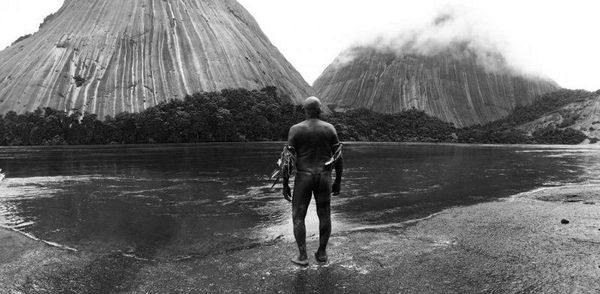Eye For Film >> Movies >> Embrace Of The Serpent (2015) Film Review
Embrace Of The Serpent
Reviewed by: Rebecca Naughten

Skilfully entwining two eras, Embrace of the Serpent (El Abrazo De La Serpiente) tells the story of an Amazonian shaman's encounters - several decades apart - with two scientists, and his subsequent voyages up river with them in search of a sacred plant. Inspired by the travel diaries of German Theodor Koch Grunberg at around the turn of the 20th century and those of American Richard Evans Schultes in the 1940s, the film creates a fictionalised proxy for each of them - Theo (Jan Bijvoet) in the early 1900s strand and Evan (Brionne Davis) in the later era. Both men are looking for the same plant - the yakruna - and encounter the same guide, the shaman Karamakate (Nilbio Torres plays the younger incarnation of the character and Antonio Bolivar is the older version). Unusually, events are seen from the latter's point of view, allowing an original interpretation of a story that is habitually told from the perspective of white explorers.
Karamakate believes himself to be the last of the Cohiuano people - a tribe that has died out/been killed off by the actions of colonialists and neighbouring factions - but Theo brings news that others are still alive. Assisted by travelling companion Manduca (Yauenkü Miguee) - a former rubber plantation slave whose freedom was bought by the scientist - the gravely ill Theo is initially searching for the warrior-shaman because he is said to be the only man who may be able to save him.

Karamakate doesn't have much time for white men (he has seen and felt their destructive tendencies) - and is openly disgusted by Manduca's attentiveness to the scientist - but when Theo reveals that he has met other Cohiuano further up river, Karamakate agrees to guide them there and to find the sacred healing plant. What follows is an ethnographic journey through a Colombian Amazon that has been ravaged by colonialism - and the film's structure allows us to see how the effects of that last and develop over time ("They are now the worst of both worlds", Karamakate observes when he revisits one location).
The opening credits bisect Karamakate's two meetings with the scientists - Evan likewise appears through the trees in a canoe, as if history is repeating or a memory is resurfacing. Older Karamakate has a problem with his memory - and blurs dreams and memories in his recollection - a sad fate for someone who in his younger years was so committed to protecting and sustaining indigenous culture and traditions. "Don't let our song fade away," he instructs young indigenous orphans who have been taken in - and indoctrinated - by a venomous priest with whom he crosses paths alongside Theo and Manduca.
After these initial set ups of the two strands, the film intersperses the two eras so that Karamakate is continually following in his own footsteps, which structurally illustrates how the indigenous people don't see time as being a chronological straight line but as multiple realities existing simultaneously - so to him, Theo and Evan are essentially the same man.
The black and white cinematography offers an unusual representation of the jungle. The vibrant colours and attendant humidity associated with this location are absent and instead the images resemble a kind of historical war reportage - the black and white confers solemnity and veracity. But the spectre of Conrad's Heart Of Darkness is never far away and a voyage into the jungle is once more shown to be a journey into delirium and madness, ego and violence and, in this instance, tinged with the mystical and the hallucinogenic.
Writer-director Ciro Guerra gives the (hi)story back to the people to whom it really belongs rather than retreading Western explorations and observations of cultures and traditions too readily misunderstood and dismissed. A testament to what was lost, Embrace of the Serpent nonetheless ensures that some songs won't fade away.
Reviewed on: 10 Apr 2016
















